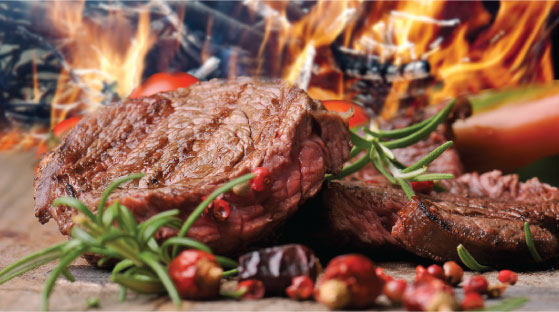Should we eat this, that or neither? Behnaz Sanjana takes a look at the most common food myths and gets expert thoughts to some pertinent questions.
Food fads, they’ve been around for a long while now. Every so often, new super foods are ushered in and old staples are unceremoniously denounced. But what’s really good for us and what’s just the latest hype? Preeti Karunakar, dietician at Middle East Hospital, gives us some straight answers.

Butter Vs Margarine
Preeti says that butter, a dietary staple for centuries, is made by churning the fatty portion of cows’ milk. Margarine, on the other hand, is a highly processed food that was invented as a supposedly healthier option to butter. Its primary ingredient is vegetable oil, along with emulsifiers, colourants and various artificial ingredients.
She continues: “Margarine is made with vegetable oil, when it is liquid at room temperature. To give it a harder consistency and shelf life, it is hydrogenated. Hydrogenation turns some of the vegetable oils into trans fats. As a general rule, the harder the margarine, the more trans fat it contains.”
You’ll realise the pros and cons of margarine, as Preeti explains it. “As it is processed from vegetable fat, it contains mono and poly unsaturated fats, which help lower one’s total and LDL cholesterol in the short term. But, if it is hydrogenated [as many brands in the market are], the trans fats in it are far more dangerous than natural, saturated butter.”
Most margarines contain little or no cholesterol and people often worry about the amount of cholesterol found in butter, animal products, coconut oil and palm oil.
But she brings us good news: “Recent research shows that the body creates cholesterol in much larger amounts than what you eat. Cholesterol in food does not necessarily affect your blood cholesterol levels. As a result, having a measured quantity of one tablespoon of butter, which is a natural product, does less harm than having processed foods, which we need to rule out from our daily diet.”
Trans fats (a.k.a partially hydrogenated oil) raise your bad (LDL) cholesterol levels and lower your good (HDL) cholesterol levels. They hide in baked goodies – cakes, cookies, pie crusts and crackers – and increase your risk of developing heart disease, type 2 diabetes and stroke.

Nothing Fishy about It
Our expert endorses eating fish at least twice a week to obtain heart-health benefits from their omega-3 fats. “Tuna and salmon are both healthy options,” she says. “Tuna is lower in calories and also provides more protein with less fat. Salmon provides loads of omega-3 fatty acids, which are also extremely important for good health.” To put it in a nutshell: “The choice would be tuna, vis-à-vis salmon, but do have salmon in small portions for its abundance in good fatty acids. However, pregnant women must avoid tuna due to its high mercury levels.”
In the debate over farmed versus wild-caught fish, there is no concrete conclusion yet. Farmed fish are bred in enclosed tanks and contain lower levels of heavy metal contaminants, pollutants and pesticides. But modern-day fish farming can have a negative impact on natural ecosystems. Make a wise choice by buying local seafood and check whether it comes from a sustainable source.
Eggs – Free Range or Factory?
Preeti says the answer to this lies in the term ‘free range’, as these eggs will be produced by chickens bred in open pastures. The birds are allowed to forage for their natural food and thus their eggs have healthy, organic benefits. She lists the edge that free range eggs have over factory produced ones: twice as many omega-3 fatty acids, three times more vitamin E, seven times more pro-vitamin A beta-carotene, a quarter less saturated fat and a third less cholesterol.
The answer here is clear – it seems wiser to spend the extra money on buying the good stuff for yourself and your family. She informs us that chickens that are caged in cramped spaces, are artificially fed and have no exposure to natural light, are usually unhealthy and lay eggs with much lesser health benefits. Moreover, they are loaded with antibiotics and unnatural hormones to make them grow very fast and keep them disease-free, something that can be harmful to our health in the long term.
Much Ado about Organic
Organic produce is usually grown with the help of naturally derived pesticides that are less toxic than conventional synthetic ones. However, it is often more expensive, so it may be prudent to strike a balance in buying organic and non-organic. Some fruits and vegetables where the organic label matters most are apples, cucumbers, celery, potatoes and spinach. Those for which it’s thought to be less important are asparagus, avocados, cabbage, mushrooms, eggplant, mango and onions.
In general, your best bet is to buy local produce which is in season. “Fruits and vegetables are the richest source of fibre and are loaded with water-soluble vitamins and minerals. Two and a half cups or two to three servings each day is ideal for the body,” says our expert.
A prudent approach would be to wash and scrub all produce thoroughly and eat a varied, nutrient-dense diet.

Red meat – Is it really the devil?
Preeti says: “Red meat is a source of animal protein which contains a higher amount of saturation and cholesterol compared with white meats. It contains higher levels of fat, but also contains higher levels of vitamins, such as iron, zinc and the essential B vitamins. The iron present in red meat is a type called heme iron, which is more easily absorbed by the body compared to iron found in plant sources.”
However, heavy consumption of red meat has been correlated with increased incidence of certain cancers, specifically colorectal cancer. What also matters is how you cook it. Our expert says: “High-temperature cooking, like grilling, can form carcinogenic [cancer-causing] compounds in the meat. This is especially true for charred meats.” So, better not overdo the barbeque!
So how much is too much? “There are certain medical conditions where red meat needs to be restricted, so the consumption of each individual varies. A normal, healthy adult can have 70 to 80gm, which is around three ounces of meat, three times a week with no evidence of any medical condition,” she responds.
Choose leaner cuts of beef – the chuck, flank and roasts. When it comes to lamb and veal, chops and roasts are the leanest cuts. She warns against bacon and other processed meats as they are laden with preservatives and salt.





































